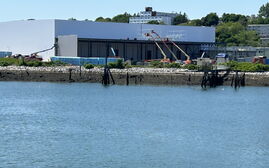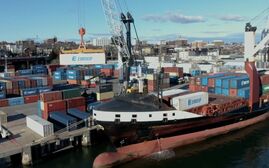
Food, medicine imports keep Portland port busy during COVID-19
 Photo / Renee Cordes
A view of Portland's International Marine Terminal from the Casco Bay Bridge.
Photo / Renee Cordes
A view of Portland's International Marine Terminal from the Casco Bay Bridge.
Portland's International Marine Terminal is a beehive of activity lately, with more food and medicine imports coming in on Eimskip container ships during the pandemic and port operations with extra safety precautions going smoothly.
"This whole situation sucks, but as far as operations at the port, I'm really proud of everyone pulling together," Jonathan Nass, CEO of the Maine Port Authority, told Mainebiz. "We've made it work, we've been operating continuously, we have a ship every week, and loads have been good."

In terms of cargo loads, Nass said the first quarter of this year was almost 10% over last year, while noting that volume tends to fluctuate, going from a rise in late fall to a sharp drop in December and January associated with holiday traffic.
More telling is the fact that 50% to 70% of all imports in March and April were categorized as food and medicine compared to 30% in a typical year. He said that trend continued in May.
"To me, it's just reaffirmation of the supply chain and how critical it is, and our little piece of it," Nass said, noting the contrast to terminals elsewhere in the country that have had to shut down during the pandemic.
"What we're proving is that we can step up ... and contribute to the supply chain," he added.
48 people working at the IMT
The IMT gets one Eimskip container ship a week, the last stage of a journey that starts in Reykjavik with stops in Halifax, Nova Scotia, and Argentia, Newfoundland.
About 48 people are employed at the terminal in Portland.

That breaks down into 14 International Longshoremen's Association crew members on weekends and another seven at the terminal Monday through Friday working as mechanics and yard workers; three Eimskip employees managing operations and another 15 back-office and and warehouse workers; and two Maine Port Authority employees plus seven under contract.
Nass, who has led the Maine Port Authority since 2018, said the IMT put a continuity of operations plan into place in response to the crisis before it was required to do so.
New practices include segregated work forces, disinfecting surfaces every morning and only allowing the most critical vendors onto the site for the time being.
He said that dock work is already socially separated, and that under orders from the U.S Coast Guard incoming crews are not allowed to leave a vessel when docked here.
"Typically, pre-COVID, the guys would get off [a vessel] for a day and go into Portland,” he explained. “They're not doing that. What I'm hearing is that industry-wide, crews don't want to do it anyway.“
Pilots ‘stepping up’
Nass gave a shout-out to the Portland docking pilots for implementing new industry standards and wearing personal protective equipment when opening up the bridge and boarding large vessels to take over temporary command as is the standard practice.
"They've been stepping up, and operations have been going well," he said.
All that has been happening while the facility has been in a "perpetual state of construction," Nass he puts it, with Cianbro recently pouring cement on the pier for the last stage of a three-year infrastructure improvement project funded with a $15 million FASTLane grant from the U.S. Department of Transportation.
It is expecting another crane under that grant later this year, according to Nass.
Further infrastructure improvements are envisioned after the MPA board earlier this month gave a green light for the agency to apply for up to $10 million in federal money under the recently passed Port Infrastructure Development Program.
Under a provision in the bill put in by U.S. Sen. Susan Collins, R-Maine, a portion of program funding is slated for small ports.
Nass said that a good application has a minimum of 20% non-federal or match money, and that the Maine Port Authority's plan proposes that $2 million come from state sources: $1.9 million from the Maine Department of Transportation and $100,000 from the Maine Port Authority, which recently got the green light from its board for that.
Heavy-haul road
If the MPA gets the grant, Nass said it would use the money towards building a heavy-haul road between the IMT and Merrill's Marine Terminal on Cassidy Point, where the Port Authority owns a 60,000-square-foot humidity-controlled warehouse operated by Sprague.
With a heavy-haul road, Nass said, "we can run heavy equipment back and forth without ever having to go on Commercial Street. As we grow, some of that traffic is going to be off road and better able to connect with rail."
A future cold storage warehouse at the IMT, led by Eimskip USA in collaboration with Yarmouth-based Treadwell Franklin Infrastructure and U.K.-based Amber Infrastructure is a separate project from the planned road.














0 Comments